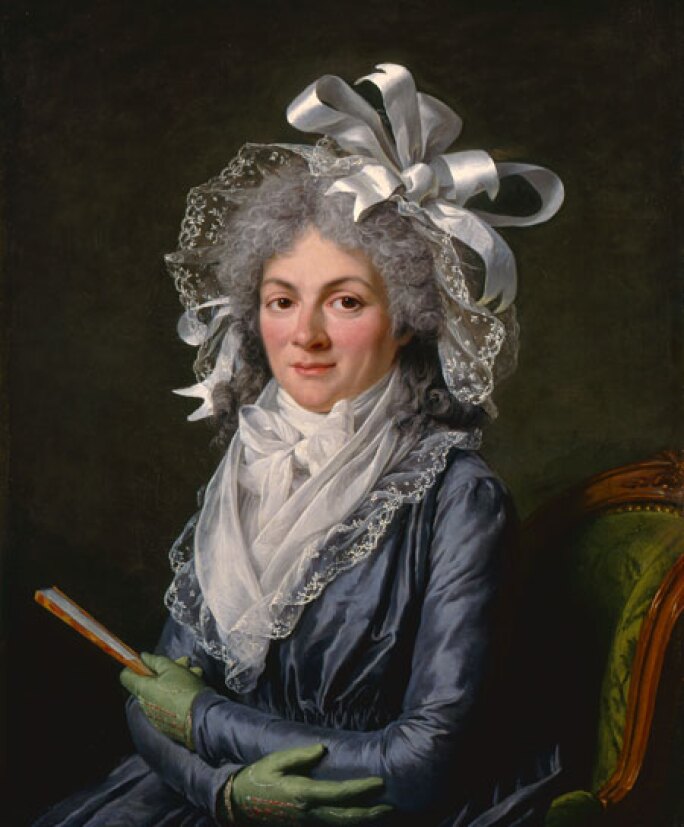Perfume always played a part in the court life of Versailles and as the 18th century progressed, new techniques emerged to add individualized scents to items of clothing. At the court of Louis XVI, one particular favourite item to subject to such a treatment was the glove. The craze for perfumed gloves was not new - it had been fashionable for at least two hundred years. In France, Catherine de Medici was credited with making the items fashionable.
The Marquis de Frangipani, a courtier of Louis XIII, was said to have been the first to apply scented grease to gloves so the scent would last longer. Others quickly caught on and the commodity spread like wildfire. To the joy of the perfumer-glove maker, gloves were a unisex item of clothing.
| French silk gloves, 1700-1725 |
In the age Louis XIV, the glove-maker was often a perfumer as well. An illustration of just how close these two spheres had grown is shown by the fact that Louis XIV granted the so-called gantiers-perfumiers (glove- and perfumer) a charter in 1656. The range in prices depicts both the quality of the gloves and of the perfume used. Louis' own perfumer, Martial, sold his precious gloves for 30 sous which was exorbitant prices - in comparison, gloves scented with jasmine were just 5 sous. During the reign of the Sun King, strong scents were generally preferred - and not to everyone's delight. Madame (Elizabeth-Charlotte) wrote to her aunt Sophia of Hannover:
"Madame, had I not been able to stand perfumes, I should long since be dead, for when I am ill, Monsieur comes to me with scented Spanish gloves!"
Even the severe Madame de Maintenon was taken in by the love of perfumed gloves. According to Madame, she also chose jessamine for her gloves. However, the fascination with perfumed gloves came with certain suspicions in the 17th century. More than once was a person suspected to have died from poisoned, scented gloves and they were considered to be dangerous to those of delicate health. Cardinal Dubois, for one, wonders if the Grande Dauphine had succumbed to a wound sustained during childbirth or because the "Princesse de Conti had approached her with perfumed gloves".
 |
| French gloves from 1750 |
Louis XV - himself a fan of perfumes - imposed a tax on French-made, scented, leather gloves in 1759. The result was that perfumed gloves once again became a luxury only available to the wealthy upper classes. Another consequence was that the 1760's saw a definite low in the use of those very items which was only revived with Louis XVI.
The tax serves to show that the production of perfumed gloves had now entered the French market. Prior to this, scented gloves were imported from either Italy or Spain - just look at Monsieur's Spanish gloves that made such an impression on Madame that she wrote to her friends about them.
Marie Antoinette's personal perfumer - Jean-Louis Fargeon - gained the attention of Marie Antoinette by presenting her with a pair of scented gloves. The perfume he chose for these kidskin gloves was a mixture of hyacinths, violets, musk jonquils and carnation. One particular aspect that undoubtedly attracted Marie Antoinette was the choice of lovely pastel colours. White had long been the colour of choice for the aristocracy's gloves but the Queen of Fashion preferred the softer tones - conveniently, they would match her dresses.
 |
| Madame de Genlis wearing green gloves - scented, perhaps? |
Élisabeth de Feydeau gives a very good description of how kidskin glove would be infused with perfume. The gloves would be placed in case between two layers of the chosen flowers. After eight days, Fargeon would retrieve the gloves and add a special touch. Rather than creating simply gloves that had a lovely scent, he wanted to go the extra mile. Therefore, the gloves were prepared with a mixture of rose water, white wax and sweet almond oil. The result was that the hands would be moistened and protected while worn. Unsurprisingly, Marie Antoinette was delighted with the invention and ordered several pairs to be given as presents.
By the late 18th century, scented gloves were a common feature in most ladies' wardrobe. Madame du Barry even received a pair from the King of Sweden as a Christmas present. The style had clearly changed from the time of Louis XIV. Whereas gloves had then been heavily embroidered and adorned with laces or even gemstones, the court of Louis XVI preferred simplicity.

No comments:
Post a Comment